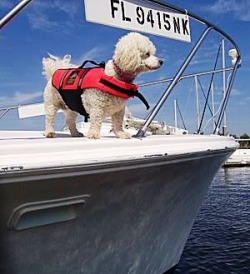Bichon Frise HISTORY

The Bichon Frise descended from the Barbet or Water Spaniel, from which came the name "Barbichon", later shortened to "Bichon". The Bichons were divided into four categories: the Bichon Maltais, the Bichon Bolognais, the Bichon Havanais and the Bichon Teneriffe. All originated in the Mediterranean area.
Because of their merry disposition, they traveled much and were often used as items of barter by sailors as they moved from continent to continent. The dogs found early success in Spain and it is generally felt that Spanish seamen introduced the breed to the Canary Island of Teneriffe.
In the 1300s Italian sailors rediscovered the little dogs on their voyages and are credited with returning them to the Continent, where they became great favorites of Italian nobility. Often, as was the style of the day with dogs in the courts, they were cut "lion style."
The "Teneriffe" or "Bichon" had success in France during the Renaissance under Francis I (1515-47) but its popularity skyrocketed in the court of Henry III (1574-89). The breed also enjoyed considerable success in Spain as a favorite of the Infantas, and painters of the Spanish school often included them in their works. For example, the famous artist, Goya, included a Bichon in several of his works.
Interest in the breed was renewed during the rule of Napoleon III, but then waned until the late 1800s when it became the "common dog", running the streets, accompanying the organ grinders of Barbary, leading the blind and doing tricks in circuses and fairs.
On March 5, 1933 the official standard of the breed was adopted by the Societe Centrale Canine of France. As the breed was known by two names at that time, "Teneriffe" and "Bichon", the president of the International Canine Federation proposed a name based on the characteristics that the dogs presented - the Bichon Frise. ("Frise" refers to the dog's soft, curly hair.) On October 18, 1934 the Bichon Frise was admitted to the stud book of the French Kennel Club.
The first Bichon litter was whelped in the U. S. in 1956. In 1959 and 1960 two breeders in different parts of the U. S. acquired Bichons. This, then, provided the origins for the breed's development in this country.
The Bichon Frise became eligible to enter the Miscellaneous Class on September 1, 1971. In October, 1972 the breed was admitted to registration in the American Kennel Club Stud Book. On April 4, 1973 the breed became eligible to show in the Non-Sporting Group at AKC dog shows.
Because of their merry disposition, they traveled much and were often used as items of barter by sailors as they moved from continent to continent. The dogs found early success in Spain and it is generally felt that Spanish seamen introduced the breed to the Canary Island of Teneriffe.
In the 1300s Italian sailors rediscovered the little dogs on their voyages and are credited with returning them to the Continent, where they became great favorites of Italian nobility. Often, as was the style of the day with dogs in the courts, they were cut "lion style."
The "Teneriffe" or "Bichon" had success in France during the Renaissance under Francis I (1515-47) but its popularity skyrocketed in the court of Henry III (1574-89). The breed also enjoyed considerable success in Spain as a favorite of the Infantas, and painters of the Spanish school often included them in their works. For example, the famous artist, Goya, included a Bichon in several of his works.
Interest in the breed was renewed during the rule of Napoleon III, but then waned until the late 1800s when it became the "common dog", running the streets, accompanying the organ grinders of Barbary, leading the blind and doing tricks in circuses and fairs.
On March 5, 1933 the official standard of the breed was adopted by the Societe Centrale Canine of France. As the breed was known by two names at that time, "Teneriffe" and "Bichon", the president of the International Canine Federation proposed a name based on the characteristics that the dogs presented - the Bichon Frise. ("Frise" refers to the dog's soft, curly hair.) On October 18, 1934 the Bichon Frise was admitted to the stud book of the French Kennel Club.
The first Bichon litter was whelped in the U. S. in 1956. In 1959 and 1960 two breeders in different parts of the U. S. acquired Bichons. This, then, provided the origins for the breed's development in this country.
The Bichon Frise became eligible to enter the Miscellaneous Class on September 1, 1971. In October, 1972 the breed was admitted to registration in the American Kennel Club Stud Book. On April 4, 1973 the breed became eligible to show in the Non-Sporting Group at AKC dog shows.
